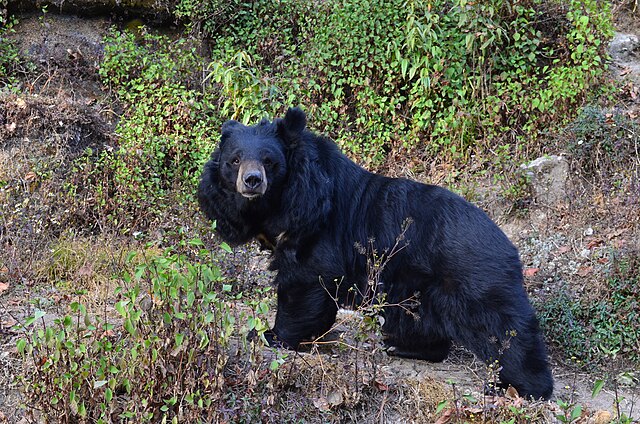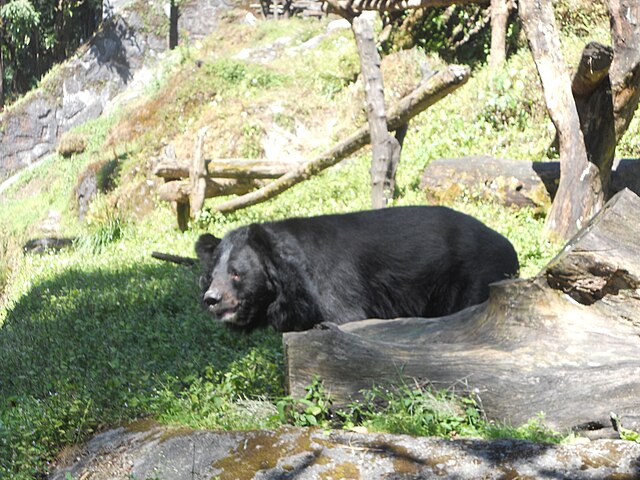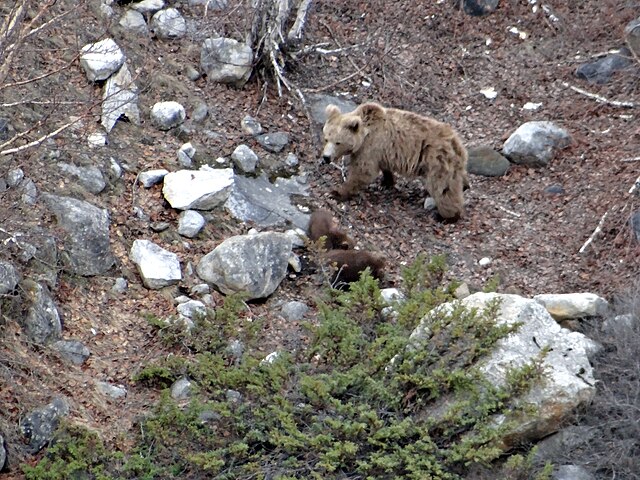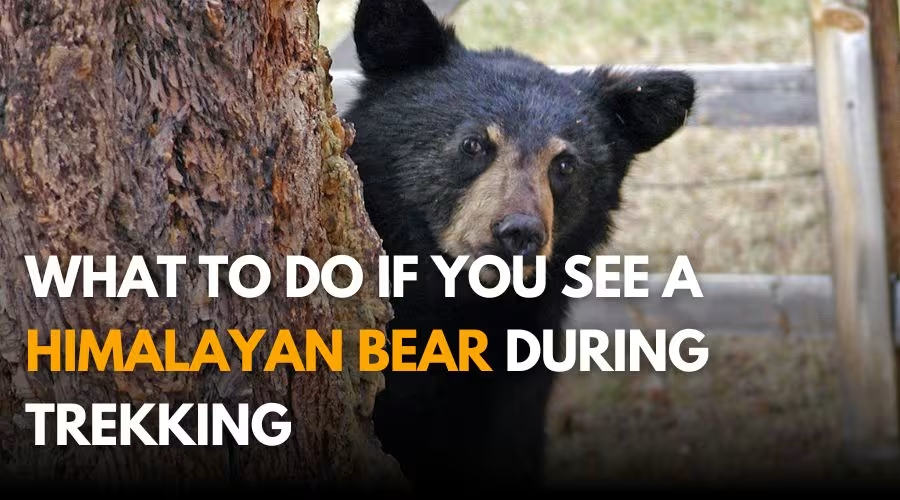Imagine you are trekking on forested trail, and suddenly a Himalayan bear hopped out from behind the bushes.
How would you react in that heart-stopping moment?
Sadly, many trekkers encounter this face-to-face situation with Himalayan bears during their treks through dense forests. In such unexpected wildlife face off, most of the hikers get frozen in fear and their minds go blank. They get too scared to make a rational decision to save themselves from any mishap.
At that scary moment, the best protection any trekker can have is courage. But when you go on a forested trek unprepared, then you are more susceptible to fainting and lose all your senses.
Furthermore, we have noticed that nowadays with the rising trend of outdoor adventures, human bear encounter cases are also increasing. Henceforth, this is the time to shed light on this human-bear conflict on Himalayan treks.
Table of Contents
Understand the Bear-Himalayas Connection

As stated by a great environmental activist, Rick Bass, “The mountains have always been here, and in them, the bears”.
Alpine meadows, pastures, valleys, and deciduous forests in the lap of snow-layered Himalayas are the ideal habitat for what mountainous bears look for. Therefore, they are widely inhabited in the Himalayan region of Northern India. Apart from this, not only do they live, but also make a significant contribution to balancing the Himalayan ecosystem.
How to avoid encountering Himalayan Bears while trekking
We have understood the reasons behind the rising human bear encounters. Now it’s time to learn the ways to avoid such encounters during off-beat hiking.
Stay updated about trek routes
Awareness is the key to being safe in outdoor adventures. What we mean to say is hikers should seek recent updates about wildlife movement on trek routes from forest departments, local residents, shepherds and trek guides before commencing on the trek expedition.
Making sounds while trekking
If Bears hear you approaching, they generally avoid a face-off with humans and move away in the dense forest. Considering this behaviour, experts advise making some noise while hiking through bear corridors. Therefore, when you cross such risky trails, put some effort to alert the bears about your presence by clapping your hands, talking with each other loudly, singing, or ringing the bear bells.
Stay on designated trails
On the grounds that bears are less likely to come on the frequented trail, it’s safe to choose the popular passage. Moreover, out of curiosity, you should avoid venturing into less-traveled paths or dense forest regions.
Do not carry attractants
The bears have an exceptionally amazing sense of smell. Surprisingly, they can smell the food items from a mile away and it can attract them to walk towards humans. In order to skip such conflict, you should avoid carrying scented items, food pouches, loosely wrapped food and crumbly remains.
Hiking in groups
For a number of reasons, bears are less likely to confront the group of hikers. On the contrary, a solo hiker is an easy target for them. Therefore, hiking in groups across bear hotspots is always a wise idea.
Avoid trekking in partial darkness
Bears remain highly active during dawn and dusk. Therefore, hikers should avoid trekking during these unusual periods, when there is partial darkness.
Watch for bear signs
If you have an eye for bear signs then it can help you to avoid an encounter. To put it simply, the bears leave some natural marks, which can help you to predict the presence of bears in close proximity. These signs are bear tracks, scat, scratch marks on trees, tufts of fur, and digging signs.
Keep your campsite clean
As we mentioned earlier, bears can sniff the food items and come towards your campsite. Therefore, it’s essential to keep that site clean where you set your overnight camp. Moreover, you should not leave food wrappers, trash, and residues in the open area around your camp to avoid night visits by bears.

How to react during a bear encounter
Stay Calm
The moment you see a Himalayan bear in front of you, calm yourself down. Neither should you look frightened nor should you look aggressive. It’s ideal to appear composed and harmless for an initial few minutes.
Do not run, and back away slowly
After a face-off, if you try to run, the bear will follow you aggressively. Hence, do not run in such a critical moment at all. What you can do is back away slowly, with posing neutral expression on your face and body language.
Maintain a safe distance
When a bear is in front of you, it’s wise to maintain a safe distance and not to block its path. If the bear wants to escape the spot, then there should be enough space to let him go.
Make yourself look stronger
If the bear takes a few steps towards you, make yourself look bigger than him. If you are a group of hikers, then stand together. Whereas, if you are alone, maintain a balanced yet stronger presence.
Identify bear behaviour
Another wise move that you should make is trying to identify bear behaviour by observing his actions keenly. During human bear encounters, generally bears can reciprocate two types of behaviour. These are defensive and predatory.
- If the bear is standing on hind legs, and his ears are inclining backwards, then most probably, it’s going to be a defensive attack. Moreover, in such situation, bear looks slightly nervous and try to protect his cubs.
- On the contrary, if his eyes and facial expression are showing aggression, ears are inclining forward and he is revolving around you, then it’s going to be a predatory attack.

How to survive a bear attack in the Himalayas
Unfortunately, if a Himalayan bear attacks you or another member of your hikers group, the only logical choice is to implement survival tactics. Observing the intent of attack, you should reciprocate in distinct ways.
Addressing this, we have shared a few tips in the below section to help you survive an unexpected bear attack.
Defensive attack
When bears feel that you might harm them or their cubs, they are most likely to charge in a defensive attack. In easy words, they just want to be assured that you are not a threat. In such a situation, you should follow the tricks below.
- Play dead
The simplest approach is that you can trick the bear by playing dead. For that you should lie down on your stomach firmly, cover your neck with clothes, head with your hands and pause or minimise breathing. For a few minutes, stay in that position and do not make any movements until the bear gets assured and takes off.
- Do not get up too early
If a bear leaves the spot, then stay in that position for a few minutes, because he can keep an eye on you secretly.
Predatory attack
If the attack is Predatory, then you should react in contrasting ways. Have a look on below given tips.
- Do not play dead
In this case, you should not play dead at all because it can only worsen the situation.
- Use bear spray
When you are face-to-face with a bear, and you see him coming towards you, then it’s time to press the trigger of the bear spray on his face and chest.
- Fight back aggressively
Lastly, when nothing works out then with all your courage, you should fight back aggressively. While fighting, take care of your face, head, and chest the most. If you have a scarf, wrap around your face and then hit the bear with a stick, or stone. During the intense fight, you should hit his face, eyes and snout, because that can make him lose easily. If the bear is so close, then you can hit his face with your fist also.
The thumb rule is that no matter how worse the fight gets, you should not surrender.
How to react in the aftermath of an Encounter
After this fierce incident, when the bears leave the spot, trekkers understand it as their final win and relax. Meanwhile, a few curious people switch on cameras and start filming the bear from behind. This is where many hikers go wrong. It’s not the moment of relaxation, it’s the moment of recovery. Therefore, here are a few tips to take wise steps in the aftermath of a bear encounter.
- Leave the spot
As soon as the bear turns its back, you should leave the area within 5 to 6 minutes. You can wait and watch him leave for 2 to 3 minutes, but do not stay at that spot for longer.
- Do not follow or track the bear
Once the bear leaves the spot, you should not follow or track him further. If you indulge in such a nuisance, the bear can take it as teasing and get aggressive.
- Join the group
During this scary incident, if you get isolated with your group, then join them as soon as possible.
- Report the encounter
In the aftermath of a bear encounter, you should act as a responsible hiker by reporting this with the concerned forest department and local authorities. So that, they can update their information and alert the hikers.
- Access your gears
After leaving the spot, you should check your important tools and gadgets to make sure that everything is in place.
- Change your route if necessary
If your instincts are alerting you about more bear encounters on the trail, then you can consider changing the route under the supervision of a trek guide.
- Mentally process the event
After walking a bit, you should drink some water, take deep breaths, and mentally process the event. It’s necessary to refresh yourself, otherwise you will keep thinking about the same and can miss out on the joy of outdoor trekking.
- Review safety practices
Before moving further, review the safety practices, so that you can be prepared for the further challenges on your trek.
Why is human-bear encounter increasing?
Suppose, your home has been suddenly demolished, then where will you go? Apparently, you will roam in the streets and try to find another temporary home.
Similar is with these innocent Himalayan bears. Due to many anthropogenic activities and climate change, their natural habitats are being destroyed. Consequently, their species is facing serious threats such as high infant mortality rate leading to a shrink in their population.
When they see their healthy habitats being spoiled, they have no choice except moving towards another place where they can find basic necessities of food and shelter.
Sadly, this is the core reason why they accidentally come towards trekking trails and human settlements, causing a rise in human-bear encounters.
To make you understand in depth, here we are naming a few activities which are exploiting Himalayan ecosystem and bear prone regions.
- Buransh (Rhododendron) Cutting: The Himalayan bears, especially brown bears, feel utmost comfort around Buransh trees. But, these vibrant flowering trees are either being cut down or overharvesting for commercial and ornamental benefits. As a consequence, bears are facing habitat loss and fragmentation.
- Impact of Timber Industrialisation: With the rising demand of timber, the long sleek deciduous and coniferous trees are also being cut down excessively. Which is ultimately displacing bears and pushing them towards homelessness.
- Conversion into Agricultural land: Another rising threat for bears is conversion of bear prone regions into agricultural land. In this process, people inflict permanent damage to the Himalayan biodiversity and the bears’ habitats.
- Poaching: Despite being illegal, many brutal individuals indulge in inhumane activities such as the poaching of Himalayan bears for the greed of monetary benefits. Poaching induces serious stress in bears, and as a result, they wander here and there for the sake of their precious life.
- Climate Change: Besides this all, climate change is also one of the emerging reasons behind forest fires and degradation of Himalayan landscapes leading to loss of habitat for bears.
The Final Word
When you go on an outdoor hike with humble approach of “Respect the wild and wild will respect you”, then you are less likely to suffer any critical incidents. However, sometimes the wild animals including Himalayan bears are unable to catch your intentions and so they respond aggressively. To handle such sensitive situations, we have shared a detailed step by step guide to survive and take exit from risky zones.
In addition, we have covered the ways to identify bear behaviours, intent of attack and ideal ways to react in aftermath of encounter. If you go through this blog sincerely and decide to adhere to the highlighted precautions, then you would be able to trek on Himalayan summits without the fear of bear encounters.
So now, when are you packing your backpack with a bear spray on reserve to hike on wildland treks?

Leave a Comment